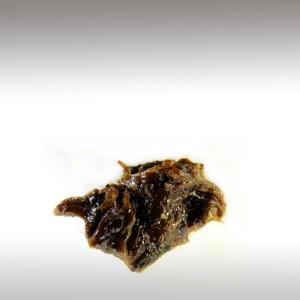
GALBANUM ESSENTIAL OIL (FERULA GALBANIFLUA) - ESSENTIAL OILS

BASE / GENERAL DATA
Information submited: March 26, 2015 Modified: March 12, 2018 By: OperaDreamhouse
Botanical Name: Ferula galbaniflua
Common Method of Extraction: Steam distilled
Part Typically Used: Oleo gum resin
Color: Pale yellow
Consistency: Thin, Viscous
Perfumery Note: Top
Strength of Initial Aroma: Fresh earthy and woody aroma with green and spicy odor.
Galbanum essential oil brings pleasure to both the mind and soul.
Galbanum is a resinous gum obtained from some species of Ferula, a family of perennial giant fennels. The Ferula Galbaniflua plant has the typical umbrella flower and seed head of it’s more familiar relatives, a thick stalk, and can grow to about 2 m in height. It is native to southern Europe, North Africa and western Asia.
Galbanum is an aromatic gum resin, the product of certain umbelliferous Persian plant species. Galbanum - yielding plants grow plentifully on the slopes of the mountain ranges of northern Iran.
The entire plant is full of a milky resin substance, and when cut it oozes. The resin hardens and then is collected. Although they are sometimes referred to as giant fennel, they are different than Fennel.
To obtain the resinous gum, incisions are made in the stalk near the roots, from which the gum runs like brown tears. This is sometimes viscous, sometimes dry, depending on the species.
Galbanum has been used through out history as incense, medicine, and perfume. It is mentioned in the Bible in the Book of Exodus as a sweet spice that is made to a perfume for the Tabernacle, ancient Greek and Roman civilizations used it for it's fragrance and medicinal qualities.
The secret of using Galbanum successfully in an Aromatherapy blend is to use very little, as often one drop may be almost too much.
The best tears are palish externally and about the size of a Hazel Nut and when broken open are composed of clear white tears.
Distilled with water it yields a quantity of essential oil, about 6 drachms, to 1 lb. of gum. It was well known to the ancients and Pliny called it "Bubonion". Galbanum under dry distillation yields a thick oil of a bluish colour, which after purification becomes the blue colour of the oil obtained from the flowers of Matricaria Chamomilla.
Chemical structure:
It contains about 8%terpenes: about 65% of a resin which contains sulfur: about 20% gum: and a very small quantity of the colorless crystalline substance umbelliferone. It also contains a-pinene, b-pinene, limonene, cadinene, 3-carene, and ocimene.
Common Method of Extraction: Steam distilled
Part Typically Used: Oleo gum resin
Color: Pale yellow
Consistency: Thin, Viscous
Perfumery Note: Top
Strength of Initial Aroma: Fresh earthy and woody aroma with green and spicy odor.
Galbanum essential oil brings pleasure to both the mind and soul.
Galbanum is a resinous gum obtained from some species of Ferula, a family of perennial giant fennels. The Ferula Galbaniflua plant has the typical umbrella flower and seed head of it’s more familiar relatives, a thick stalk, and can grow to about 2 m in height. It is native to southern Europe, North Africa and western Asia.
Galbanum is an aromatic gum resin, the product of certain umbelliferous Persian plant species. Galbanum - yielding plants grow plentifully on the slopes of the mountain ranges of northern Iran.
The entire plant is full of a milky resin substance, and when cut it oozes. The resin hardens and then is collected. Although they are sometimes referred to as giant fennel, they are different than Fennel.
To obtain the resinous gum, incisions are made in the stalk near the roots, from which the gum runs like brown tears. This is sometimes viscous, sometimes dry, depending on the species.
Galbanum has been used through out history as incense, medicine, and perfume. It is mentioned in the Bible in the Book of Exodus as a sweet spice that is made to a perfume for the Tabernacle, ancient Greek and Roman civilizations used it for it's fragrance and medicinal qualities.
The secret of using Galbanum successfully in an Aromatherapy blend is to use very little, as often one drop may be almost too much.
The best tears are palish externally and about the size of a Hazel Nut and when broken open are composed of clear white tears.
Distilled with water it yields a quantity of essential oil, about 6 drachms, to 1 lb. of gum. It was well known to the ancients and Pliny called it "Bubonion". Galbanum under dry distillation yields a thick oil of a bluish colour, which after purification becomes the blue colour of the oil obtained from the flowers of Matricaria Chamomilla.
Chemical structure:
It contains about 8%terpenes: about 65% of a resin which contains sulfur: about 20% gum: and a very small quantity of the colorless crystalline substance umbelliferone. It also contains a-pinene, b-pinene, limonene, cadinene, 3-carene, and ocimene.

SPIRITUAL PRACTISES DATA
Information submited: March 12, 2018 By: OperaDreamhouse
Galbanum was widely used as a component of incense and is listed in the Holy Bible as part of the sweet spices used to make Holy Incense. Holy Incense was only made for the worship of the Lord and Holy communication
as it was believed to be free from evil. Preparation required certain
rituals and it was forbidden to make such incense just for the pleasure
of the senses.

MEDICINE / HEALTH DATA

BEAUTY / COSMETICS DATA

FOOD / COOKING DATA
COMMENTS
No comments.


